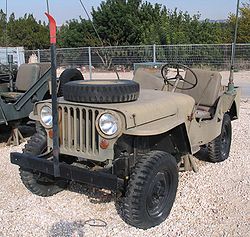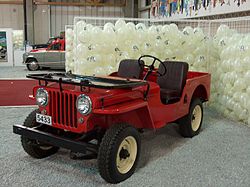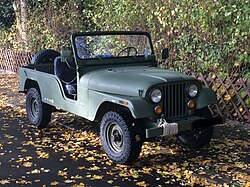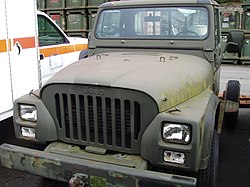Jeep CJ
| Jeep CJ | |
|---|---|
| Production period: | 1944-1986 |
| Class : | Off-road vehicle |
| Body versions : | Kübelwagen , station wagon , pickup |
| Previous model: | Willys MB |
| Successor: | Jeep Wrangler , Jeep Comanche |
The Jeep CJ (or C ivilian J eep ) was the over-the-counter version of the famous military jeep from World War II . The first CJ (the CJ-2 ) was introduced by Willys-Overland in 1944 and its basic design was retained in all seven generations through three parent companies until 1986. In fact, a variant of the CJ still exists today that is manufactured under license. The last CJ models, the CJ-7 and CJ-8 , were replaced by the revised Wrangler in 1987 . The CJ-5 and the CJ-7 are still very popular in off-road sports today, both with the original sheet steel body and as a GRP replica with a flip front from Tuxedo Park.
All models have in common that the frame with the windshield can be folded forward. There are lashing eyes attached to fix it on the bonnet .
CJ-2
| CJ-2 | |
|---|---|
|
Image does not exist |
|
| Production period: | 1944-1945 |
| Body versions : | Kübelwagen , station wagon |
| Engines: | |
| Length: | |
| Width: | |
| Height: | |
| Wheelbase : | |
| Empty weight : | |
Although the CJ-2 was a civilian jeep, it was not available for sale. Willys-Overland manufactured fewer than three dozen CJ-2s as Agrijeeps in 1944 and 1945 ; there were only 40 pieces in total. The car was based directly on the military version of the Willys MB , also had the Willys Go Devil engine used there , but was free of all obviously military details, especially the camouflage lighting. In addition to larger main headlights, a side-mounted spare wheel and an ordinary tank cap, this car was the first Jeep to have a tailgate. Eleven CJ-2 have survived to this day.
CJ-2A
| CJ-2A | |
|---|---|
| Production period: | 1945-1949 |
| Body versions : | Kübelwagen , station wagon |
| Engines: | Otto engine: 2.2 liters (46 kW) |
| Length: | 3320 mm |
| Width: | 1500 mm |
| Height: | 1750 mm |
| Wheelbase : | 2032 mm |
| Empty weight : | 827 kg |
Experience with the CJ-2 led to the development of the first truly free-for-sale civilian jeep, the CJ-2A, which was manufactured from 1945 to 1949 . Like the CJ-2 and the military jeep, the CJ-2A had a split windshield. The steering wheel shift that was initially used was replaced over time by the more common middle shift and Borg-Warner T90 transmission. The three-speed gearbox with steering wheel was introduced because it was thought that the troops returning from the war needed changes to the jeep; ironically, many of the early CJ-2As were made from leftover military parts. The CJ-2A was intended for use in agriculture and therefore had a lower gear ratio than its military counterpart. A total of 214,202 CJ-2A were manufactured.
CJ-3A
| CJ-3A | |
|---|---|
| Production period: | 1949-1953 |
| Body versions : | Kübelwagen , station wagon |
| Engines: | Otto engine: 2.2 liters (46 kW) |
| Length: | 3300 mm |
| Width: | 1500 mm |
| Height: | 1700 mm |
| Wheelbase : | 2032 mm |
| Empty weight : | 823 kg |
The CJ-3A was introduced in 1949 and replaced its predecessor the following year. It had a one-piece windshield with ventilation. From 1951 there was also a stripped down farm jeep . By 1953, 131,843 CJ-3A Jeeps had been produced. The military variant of the CJ-3A is the M38 .
CJ-4
| CJ-4 | |
|---|---|
|
Image does not exist |
|
| Production period: | 1951 |
| Body versions : | Kübelwagen , station wagon |
| Engines: | |
| Length: | |
| Width: | |
| Height: | |
| Wheelbase : | 2057 mm |
| Empty weight : | |
Only a single CJ-4 was built as a test vehicle in 1951. It had the new Willys Hurricane engine and a wheelbase of 2,184 mm. The construction of the CJ-4 stood between that of the CJ-3B with its towering bonnet and that of the CJ-5 with its more rounded lines. The model fell through with the management and the only vehicle was probably sold to a factory employee.
CJ-3B
| CJ-3B | |
|---|---|
| Production period: | 1953-1968 |
| Body versions : | Kübelwagen , station wagon |
| Engines: | Otto engine: 2.2 liters (55 kW) |
| Length: | 3300 mm |
| Width: | 1500 mm |
| Height: | 1680 mm |
| Wheelbase : | 2032 mm |
| Empty weight : | 837 kg |
The CJ-3B replaced the CJ-3A in 1953, the year Willys-Overland was sold to Kaiser . The car had a taller grille and hood to accommodate the new Willys Hurricane engine. Exactly 155,494 of this variant were built up to 1968; the design had been licensed to various foreign manufacturers, for example Mitsubishi in Japan and Mahindra in India . Mitsubishi stopped selling vehicles based on the CJ-3B in 1998, but Mahindra continues to build the Jeeps today (with a Peugeot diesel engine ).
CJ-5
| CJ-5 | |
|---|---|
| Production period: | 1954-1983 |
| Body versions : | Kübelwagen , station wagon |
| Engines: |
Otto engines : 2.2–6.9 liters Diesel engine : 3.7 liters |
| Length: | 3250 mm |
| Width: | 1480 mm |
| Height: | 1890 mm |
| Wheelbase : | 1954-1971: 2057 mm. 1972-1983: 2121 mm |
| Empty weight : | 1031 kg |
The CJ-5 was minted by the new company owner Kaiser and the new military version M38A1 for the Korean War . The original intention was to replace the CJ-3B, but the model stayed in production. The CJ-5 was also made for three decades, although three newer variants appeared during that time. From 1954 to 1983, 603,303 CJ-5s were built.
In 1965 Kaiser bought the rights to the construction of the Buick V6 Dauntless engine with 3687 cc displacement, and so the CJ-5 and the CJ-6 got a new engine with 114 kW of power, which was the old Willys Hurricane - Replaced engine. 1969–1970 Tuxedo Park offered either a steel body or a fiberglass body.
In 1970 the company was sold to the American Motors Corporation and in the 1972 model year the GM engine was no longer installed. GM's Buick division bought back the tools for this engine in the early 1970s, which then served as the power source for various GM vehicles. AMC then used its in-line six-cylinder engines with 3802 cm³ and 4228 cm³ displacement and in 1972 there was a V8 engine that corresponded to that of the muscle car with 4982 cm³.
To make room for the new in-line six-cylinder, the front fenders and the bonnet were lengthened by 76 mm from 1972. There were also some small changes to the drive.
In 1976 the cab and frame were slightly changed. The windshield frame also changed, which means that the bodies of a CJ-5 (1955–1975) do not fit on a CJ-5 (1976–1983) and vice versa.
In the early 1980s there was a version of the GM Iron Duke in-line four-cylinder engine called the Hurricane for the CJ .
The following special models were built by the CJ-5:
- 1961–1963 Tuxedo Park Mark III
- 1965 Tuxedo Park Mark IV
- 1969 camper
- 1969 462
- 1969–1970 Tuxedo Park Mark IV BigBlock 427cubi and the Quadra-Trac transfer case in conjunction with the TH400 automatic transmission from GM
- 1970 Renegade I.
- 1971 Renegade II
- 1972–1983 Renegade models - with 4,981 cc V8 engine, light alloy wheels and limited-slip differentials
- 1973 super jeep
- 1977-1983 Golden Eagle
The model was assembled in Iran from 1959 to 1974 as the first Iranian car model by Jeep Trading and is known there under the name Jeep Shahbaz . It was available with both a soft top and a hard top .
CJ-6
| CJ-6 | |
|---|---|
|
CJ-6 1975 |
|
| Production period: | 1955-1975 |
| Body versions : | Kübelwagen , station wagon |
| Engines: |
Gasoline engines : 3.7-5.0 liters |
| Length: | |
| Width: | |
| Height: | |
| Wheelbase : | 2565 mm |
| Empty weight : | |
The CJ-6 was simply a 508 mm longer version (wheelbase: 2565 mm) of the CJ-5. It was introduced in 1955 as the "1956 Model" but was not very popular in the US. Most of the CJ-6s were sold to Sweden and South America . The United States Forest Service procured some CJ-6s. Former US President Ronald Reagan owned a 1962 CJ-6 that he used on his ranch in California . In 1975 sales in the USA were stopped. When the series was taken out of the program in 1981, only 50,172 pieces had been created. As with the CJ-5, there was a V6 engine from 1965 and a V8 engine (AMC) and a V8 1969-1970 (GM) from 1972
CJ-5A and CJ-6A
| CJ-5A / CJ-6A | |
|---|---|
|
Image does not exist |
|
| Production period: | 1964-1968 |
| Body versions : | Kübelwagen , station wagon |
| Engines: |
Petrol engines : 2.2–6.9 liters |
| Length: | |
| Width: | |
| Height: | |
| Wheelbase : | |
| Empty weight : | |
From 1964 to 1968 Kaiser turned the Tuxedo Park equipment variant into its own models, the CJ-5A and the CJ-6A. A Tuxedo Park Mark III can be recognized by a different prefix to the chassis number.
CJ-7
| CJ-7 | |
|---|---|
| Production period: | 1976-1986 |
| Body versions : | Kübelwagen , station wagon |
| Engines: |
Gasoline engines : 2.0-5.0 liters |
| Length: | 3950 mm |
| Width: | 1660 mm |
| Height: | 1850 mm |
| Wheelbase : | 2372 mm |
| Empty weight : | 1450 kg |
engine
- Renault J5R (2.0 l)
- AMC 150 R4 (2.5 l)
- AMC 258 R6 (4.2 l)
- AMC 304 V8 (5.0 l) (until 1981)
transmission
- Warner T-18 (4-speed)
- Warner T-150 (3-speed)
- Warner T-176 (4-speed)
- Warner T-4 (4-speed)
- Warner T-5 (5-speed)
- Automatic GM TH400
Power transmission
- Dana 20 (1976-1979)
- Dana 300 (1980-1986)
axes
- Dana 30 front (1976–1986)
- Two-piece AMC 20 rear (1976–1986)
- Dana 44 rear (1986)
The CJ-7 had a longer wheelbase than the CJ-5 and not the eye-catching curve of the doors. It was introduced in 1976 and 379,299 units were made in eleven years of production. The CJ-7 had a new automatic four-wheel drive - called Quadra-Trac - which was not exactly known for its strength and a two-stage transmission. The Quadra-Trac transfer case was only offered in conjunction with GM's TH400 automatic transmission. A hardtop and steel doors were also available as options. In addition to the simple standard model, there was also the Renegade version of the CJ-7 and, from 1980, the better equipped Laredo model. The latter could be recognized by its different emblems; it had more elaborate seats with adjustable backrests, an adjustable steering wheel, tachometer, clock and a chrome trim package that included bumpers, grille and mirrors. There was a limited slip differential on the rear axle on request and the ratio was usually 3.54, but was later reduced to 2.73.
CJ-8
| CJ-8 | |
|---|---|
| Production period: | 1981-1986 |
| Body versions : | Kübelwagen , station wagon |
| Engines: | |
| Length: | |
| Width: | |
| Height: | |
| Wheelbase : | 2616 mm |
| Empty weight : | |
The CJ-8 Scrambler was a pickup version of the CJ-7 introduced in 1981. It had a wheelbase of 2,616 mm and a loading area. In five years, 27,792 copies were built before the model was replaced by the Comanche of the same size .
The Jeep CJ-8 did not have a Quadra-Trac system. Most of the CJ-8 had instead the usual drive components with hand-tightened wheel hubs at the front to engage the four-wheel drive. Most of the CJ-8 had a four- or five-speed manual transmission, but there was also a three-speed automatic.
CJ-10
| CJ-10 | |
|---|---|
| Production period: | 1982-1985 |
| Body versions : | Pick up |
| Engines: |
Otto engines : 2.5–4.2 liters (60–85 kW) Diesel engine : 3.3 liters |
| Length: | |
| Width: | |
| Height: | |
| Wheelbase : | |
| Empty weight : | |
The CJ-10 was a CJ-based pickup truck. The cars were powered by a four-cylinder in-line engine GM Iron Duke with 2474 cc and an output of 82 hp (60 kW) or a six-cylinder in-line engine with 4227 cc and an output of 115 hp (85 kW). Alternatively there was a diesel engine from Nissan - a six-cylinder in-line engine with 3300 cm³ displacement.
The CJ-10 was manufactured from 1982 to 1985 mainly for export, but the United States Air Force procured a few examples as towing vehicles for aircraft. The latter model, called the CJ 10a , had a shorter wheelbase and rear-wheel drive. Nevertheless, there was a transfer case (NP-208) with reduction, the front output was blind flanged.
They had rectangular headlights in the fenders and an unusual grille with nine bars. A Dana 60 rear axle was used on all models. The 4-speed manual transmission T-176 or a Chrysler automatic TF 727 were available for transmission.
See also
- Jeep Wrangler (which replaced the CJ series in 1987)
- A duke rarely comes alone









